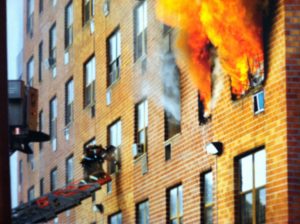
Aerial as a Standpipe
August 9, 2021Recruit Performance Standards
August 9, 2021Objectives
- Provide optional method for stretching attack lines above grade, in a stairwell.
- Provides a greater amount of working line than a traditional stairwell stretch.
Why the well hole?
When you are advancing the hose line above grade it is easy to eat up all of your length with a regular stairway stretch. The normal stretch is 50 feet to the door, 50 feet per floor, and then you want at least 50 feet to cover a normal sized apartment. So you have used all of your 200 ft pre-connect by going to the third floor. With the well hole stretch you can advance much higher in the building while keeping the stairway clear for residents and fire crews.
The stretch
The first thing the fire officer needs to do is identify the fire floor and the location of the fire on that floor. While they are making their way to the fire floor the fire officer needs to decide if the well hole is large enough for the hose to pass up cleanly. (The well hole is the space between the stair pans, the one at the tower is just large enough for a 1 3/4 hose to pass up it)
The officer then radios down that they want a pre-connect well hole stretch. Now there are two ways that I like to advance the hose up to the fire floor.
OPTION ONE
- The first way is for one firefighter to shoulder load 100 feet of the pre-connect and start walking toward the building.
- The second firefighter pulls the other hose out of the hose bed and flakes it out on the ground and then goes to the bottom of the stairs where the well hole begins.
- The first firefighter keeps the hose on their shoulder and begins walking up the stairs pulling hose up behind them.
- The second firefighter feeds the hose into the well hose and makes sure that the hose passes freely as the first firefighter walks up the stairs.
- Once the first firefighter reaches the location the officer wants, they can drop the hose and have the second firefighter join them.
- Now one firefighter flakes out the hose on the landing or up the stairs while the other firefighter secures the hose to the handrail. (Use your hose strap to girth hitch the hose below the coupling then wrap the handrail several times and clip the strap back onto itself with a carabineer, or tie it off with a clove hitch.)
- The hose can now be loaded and advanced into the fire floor.
OPTION TWO
- The second way to perform the well hole stretch is to flake all the hose on the ground
- The first firefighter now grabs the nozzle and starts walking up the stairs.
- The second firefighter feeds the hose into the well hole and makes sure it moves up smoothly.
- Once the first firefighter reaches the floor the officer wants they now have to pull hose up the well hole until they have 100 feet on the fire floor.
- The second firefighter joins them and secures the hose as mentioned above.
I think the first method works better, but if you are going to use the well hole for multiple lines the second method has to be used for the additional lines. The reason is because the firefighter has to pass the nozzle around the hose that is already in the well hole on each landing or you will create a barber pole effect where the second hose wraps around the first and can kink it.
The key thing in this drill is hose management. Once the hose is on the landing that the fire officer indicated, a few extra seconds to flake out your hose correctly will save a lot of trouble once you start to advance into the fire floor. Also having a doorman stay behind and feed hose as the nozzle man and the officer advance the line helps the evolution go smoother.
Drill submitted by Division Chief Fox
